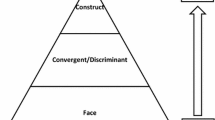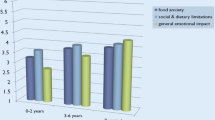Abstract
The diagnosis of a food allergy generally has a considerable impact on patients. Not does it result in dietary restrictions, it is often also associated with a constant threat scenario, given the risk of sudden allergic reactions, including life-threatening anaphylaxis. It is essential for patients to receive training on how to deal with emergency situations and make the correct decision regarding the use of emergency medication. Severe allergic reactions occur only rarely if patients are well informed. However, the fear of allergic reactions results in a significant impairment in quality of life (QoL).
In recent years, numerous studies have been carried out on QoL in food-allergy and anaphylaxis patients. These studies provide insight into patient behaviour in everyday life. More importantly, by means of targeted and specific counselling, they also make it possible to reduce adverse effects on QoL and improve avoidance behaviour and compliance in terms of the requisite emergency measures.
The present article summarizes the available data and formulates recommendations aimed at improving the care of food-allergy patients in terms of QoL and compliance.

Similar content being viewed by others
Abbreviations
- AAI:
-
Adrenaline autoinjector
- AGATE:
-
Arbeitsgemeinschaft Anaphylaxie Training und Edukation e.V.
- FAQLQ:
-
Food allergy quality of life questionnaire
- FAQLQ-AF:
-
Food allergy quality of life questionnaire adult form
- HRQoL:
-
Health-related quality of life
- IgE:
-
Immunglobulin E
- QoL:
-
Quality of life
Literatur
Umasunthar T, Leonardi-Bee J, Hodes M, Turner PJ, Gore C, Habibi P et al. Incidence of fatal food anaphylaxis in people with food allergy: a systematic review and meta-analysis. Clin Exp Allergy 2013;43:1333–41
Beyer K, Eckermann O, Hompes S, Grabenhenrich L, Worm M. Anaphylaxis in an emergency setting - elicitors, therapy and incidence of severe allergic reactions. Allergy 2012;67:1451–6
Grabenhenrich L, Hompes S, Gough H, Ruëff F, Scherer K, Pföhler C et al. Implementation of anaphylaxis management guidelines: a register-based study. PLoS One 2012;7:e35778
Flokstra-de Blok BM, Dubois AE. Quality of life measures for food allergy. Clin Exp Allergy 2012;42:1014–20
Flokstra-de Blok BM, Dubois AE. Quality of life in food allergy: valid scales for children and adults. Curr Opin Allergy Clin Immunol 2009;9:214–21
Flokstra-de Blok BMJ, Dubois AEJ, Vlieg-Boerstra BJ, Oude Elberink JNG, Raat H, DunnGalvin A et al. Health related quality of life of food allergic patients: comparison with the general population and other diseases. Allergy 2010;65:238–44
Flokstra-de Blok BM, DunnGalvin A, Vlieg-Boerstra BJ, Oude Elberink JN, Duiverman EJ, Hourihane JO et al. Development and validation of a self-administered Food Allergy Quality of Life Questionnaire for children. Clin Exp Allergy 2009;39:127–37
Flokstra-de Blok BM, DunnGalvin A, Vlieg-Boerstra BJ, Oude Elberink JN, Duiverman EJ, Hourihane JO et al. Development and validation of the self-administered Food Allergy Qualityof Life Questionnaire for adolescents. J Allergy Clin Immunol 2008;122:139–44
Flokstra-de Blok BM, Meulen GN van der, DunnGalvin A, Vlieg-Boerstra BJ, Oude Elberink JN, Duiverman EJ et al. Development and validation of the Food Allergy Quality of Life Questionnaire - adult form. Allergy 2009;64:1209–17
DunnGalvin A, Flokstra de Blok BM, Burks AW, Dubois AE, Hourihane JO. Food allergy QoL questionnaire for children aged 0-12 years: content, construct, and cross-cultural validity. Clin Exp Allergy 2008;38:977–86
Velde JL van der, Flokstra-de Blok BM, Vlieg-Boerstra BJ, Oude Elberink JN, Schouten JP, Dunngalvin A et al. Testretest reliability of the Food Allergy Quality of Life Questionnaires (FAQLQ) for children, adolescents and adults. Qual Life Res 2009;18:245–51
Avery NJ, King RM, Knight S, Hourihane JO. Assessment of quality of life in children with peanut allergy. Pediatr Allergy Immunol 2003;14:378–82
Cummings AJ, Knibb RC, King RM, Lucas JS. The psychosocial impact of food allergy and food hypersensitivity in children, adolescents and their families: a review. Allergy 2010;65:933–45
King RM, Knibb RC, Hourihane JO. Impact of peanut allergy on quality of life, stress and anxiety in the family. Allergy 2009;64:461–8
Lyons AC, Forde EM. Food allergy in young adults: perceptions and psychological effects. J Health Psychol 2004;9:497–504
Sicherer SH, Noone SA, Munoz-Furlong A. The impact of childhood food allergy on quality of life. Ann Allergy Asthma Immunol 2001;87:461–4
Marklund B, Ahlstedt S, Nordstrom G. Health-related quality of life in food hypersensitive schoolchildren and their families: parents’ perceptions. Health Qual Life Outcomes 2006;4:48
Marklund B, Ahlstedt S, Nordstrom G. Health-related quality of life among adolescents with allergy-like conditions - with emphasis on food hypersensitivity. Health Qual Life Outcomes 2004;2:65
Wassenberg J, Cochard MM, Dunngalvin A, Ballabeni P, Flokstra-de Blok BM, Newman CJ et al. Parent perceived quality of life is age-dependent in children with food allergy. Pediatr Allergy Immunol 2012;23:412–9
Bollinger ME, Dahlquist LM, Mudd K, Sonntag C, Dillinger L, McKenna K. The impact of food allergy on the daily activities of children and their families. Ann Allergy Asthma Immunol 2006;96:415–21
Gillespie CA, Woodgate RL, Chalmers KI, Watson WT. „Living with risk’’: mothering a child with food-induced anaphylaxis. J Pediatr Nurs 2007;22:30–42
Calsbeek H, Rijken M, Dekker J, Berge Henegouwen GP van. Disease characteristics as determinants of the labour market position of adolescents and young adults with chronic digestive disorders. Eur J Gastroenterol Hepatol 2006;18:203–9
Munoz-Furlong A. Daily coping strategies for patients and their families. Pediatrics 2003;111:1654–61
Shemesh E, Annunziato RA, Ambrose MA, Ravid NL, Mullarkey C, Rubes M, Chuang K, Sicherer M, Sicherer SH. Child and parental reports of bullying in a consecutive sample of children with food allergy. Pediatrics 2013;131:e10–7
Primeau MN, Kagan R, Joseph L, Lim H, Dufresne C, Duffy C et al. The psychological burden of peanut allergy as perceived by adults with peanut allergy and the parents of peanut-allergic children. Clin Exp Allergy 2000;30:1135–43
Mandell D, Curtis R, Gold M, Hardie S. Anaphylaxis: how do you live with it? Health Soc Work 2005;30:325–35
Herbert LJ, Dahlquist LM. Perceived history of anaphylaxis and parental overprotection, autonomy, anxiety, and depression in food allergic young adults. J Clin Psychol Med Settings 2008;15:261–9
Knibb RC, Semper HM. Anxiety and depression in parents with food allergic children before and after food allergy diagnosis. Psychol Health 2008;23:161
Kelleher MM, Dunngalvin A, Sheikh A, Cullinane C, Fitzsimons J, Hourihane JO. Twenty four-hour helpline access to expert management advice for food-allergy-triggered anaphylaxis in infants, children and young people: a pragmatic, randomized controlled trial. Allergy 2013;68: 1598–604
Simons FER, Clark S, Camargo CA Jr. Anaphylaxis in the community: learning from the survivors. J Allergy Clin Immunol 2009;124:301–6
Arkwright PD, Farragher AJ. Factors determining the ability of parents to effectively administer intramuscular adrenaline to food allergic children. Pediatr Allergy Immunol 2006;17:227–9
Sampson MA, Munoz-Furlong A, Sicherer SH. Risk-taking and coping strategies of adolescents and young adults with food allergy. J Allergy Clin Immunol 2006;117:1440–5
Lyons AC, Forde EM. Food allergy in young adults: perceptions and psychological effects. J Health Psychol 2004;9:497–504
Monks H, Gowland MH, MacKenzie H, Erlewyn-Lajeunesse M, King R, Lucas JS, Roberts G. How do teenagers manage their food allergies? Clin Exp Allergy 2010;40:1533–40
Akeson N, Worth A, Sheikh A. The psychosocial impact of anaphylaxis on young people and their parents. Clin Exp Allergy 2007;37:1213–20
Macadam C, Barnett J, Roberts G, Stiefel G, King R, Erlewyn-Lajeunesse M et al. What factors affect the carriage of epinephrine auto-injektors by teenagers. Clin Trans Allergy 2012;2:3
Marrs T, Lack G. Why do few food-allergic adolescents treat anaphylaxis with adrenaline? — Reviewing a pressing issue. Pediatr Allergy Immunol 2013;24(3):222–9
Le TM, Flokstra-de Blok BM, Hoffen E van, Lebens AF, Goossens NJ, Dubois AE et al. Quality of life is more impaired in patients seeking medical care for food allergy. Int Arch Allergy Immunol 2013;162:335–9
Ellert U, Kurth BM. [Health-related quality of life in adults in Germany: results of the German Health Interview and Examination Survey for Adults (DEGS1)]. Bundesgesundheitsbl Gesundheitsforsch Gesundheitsschutz 2013;56:643–9
Jansson SA, Heibert-Arnlind M, Middelveld RJ, Bengtsson UJ, Sundqvist AC, Kallström-Bengtsson I. Health-related quality of life, assessed with a disease-specific questionnaire, in Swedish adults suffering from well-diagnosed food allergy to staple foods. Clin Transl Allergy 2013;3:21
Kramer S, Franke A, Simon JC, Treudler R. Health related Quality of Life bei 73 Birkenpollenallergikern mit pollenassoziierter Nahrungsmittelallergie. Allergo J 2010;19:17
Kramer S, Simon JC, Treudler R. Birch associated soy allergy is frequent and causes impairment of quality of life. Allergy 2009;64:47
Cummings AJ, Knibb RC, Erlewyn-Lajeunesse M, King RM, Roberts G, Lucas JS. Management of nut allergy influences quality of life and anxiety in children and their mothers. Pediatr Allergy Immunol 2010;21:586–94
Pinczower GD, Bertalli NA, Bussmann N, Hamidon M, Allen KJ, Dunngalvin A et al. The effect of provision of an adrenaline autoinjector on quality of life in children with food allergy. J Allergy Clin Immunol 2013;131:238–40
Chad L, Ben-Shoshan M, Asai Y, Cherkaoui S, Alizadehfar R, St-Pierre Y et al. A majority of parents of children with peanut allergy fear using the epinephrine auto-injector. Allergy 2013;68:1605–9
Gallagher M, Worth A, Cunningham-Burley S, Sheikh A. Epinephrine autoinjector use in adolescents at risk of anaphylaxis: a qualitative study in Scotland, UK. Clin Exp Allergy 2011;41:869–77
Joshi P, Mofidi S, Sicherer SH. Interpretation of commercial food ingredient labels by parents of food-allergic children. J Allergy Clin Immunol 2002;109:1019–21
Barnett J, Leftwich J, Muncer K, Grimshaw K, Shepherd R, Raats MM et al. How do peanut and nut-allergic consumers use information on the packaging to avoid allergens? Allergy 2011;66:969–78
Barnett J, Vasileiou K, Gowland MH, Raats MM, Lucas JS. Beyond labelling: What strategies do nut allergic individuals employ to make food choices? A qualitative study. PLoS One 2013;8:e55293
Velde JL van der, Flokstra-de Blok BM, Groot H de, Oude-Elberink JN, Kerkhof M, Duiverman EJ et al. Food allergyrelated quality of life after double-blind, placebo-controlled food challenges in adults, adolescents, and children. J Allergy Clin Immunol 2012;130:1136–43
Knibb RC, Ibrahim NF, Stiefel G, Petley R, Cummings AJ, King RM et al. The psychological impact of diagnostic food challenges to confirm the resolution of peanut or tree nut allergy. Clin Exp Allergy 2012;42:451–9
DunnGalvin A, Cullinane C, Daly DA, Flokstra-de Blok BM, Dubois AE, Hourihane JO. Longitudinal validity and responsiveness of the Food Allergy Quality of Life Questionnaire - Parent Form in children 0-12 years following positive and negative food challenges. Clin Exp Allergy 2010;40:476–85
Zijlstra WT, Flinterman AE, Soeters L, Knulst AC, Sinnema G, L’Hoir MP, Pasmans SG. Parental anxiety before and after food challenges in children with suspected peanut and hazelnut allergy. Pediatr Allergy Immunol 2010;21:439–45
Finger A, Pfannenstiel C, Schönfelder A, Frank F, Buderus S, Lange L. Improvement of quality of life in children with milk and egg allergy after proof of tolerance to baked products. Allergy 2012;67;Suppl n96:87
Acknowledgement
My thanks go to Prof. Dr. Uwe Gieler for his critical review of the manuscript.
Author information
Authors and Affiliations
Corresponding author
Additional information
Conflict of interest
The corresponding author states that there are no conflicts of interest
Cite this as
Lange L. Quality of life in the setting of anaphylaxis and food allergy. Allergo J Int 2014; 23:252–60 DOI: 10.1007/s40629-014-0029-x
Rights and permissions
About this article
Cite this article
Lange, L. Quality of life in the setting of anaphylaxis and food allergy. Allergo J Int 23, 252–260 (2014). https://doi.org/10.1007/s40629-014-0029-x
Received:
Accepted:
Published:
Issue Date:
DOI: https://doi.org/10.1007/s40629-014-0029-x




